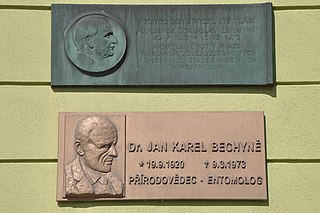
Clinidium is a genus of wrinkled bark beetles in the family Rhysodidae. Most species are Neotropical, but some occur further north in North America and there is also one species in Europe and one in Japan. Two species are known from Miocene amber.
Clinidium excavatum is a species of ground beetle in the subfamily Rhysodinae. It was described by R.T. Bell & J.R. Bell in 1985. It is known from its type locality in Carabobo, northern Venezuela. Clinidium excavatum measure 6.5–6.8 mm (0.26–0.27 in) in length.
Clinidium humboldti is a species of ground beetle in the subfamily Rhysodinae. It was described by R.T. & J.R. Bell in 1985. It is named for Alexander von Humboldt and the Humboldt Museum, from where the holotype was borrowed. It is known from "Nueva Granada", which could be in either present-day Colombia or Panama. The holotype is a female measuring 6.4 mm (0.25 in) in length.
Clinidium kochalkai is a species of ground beetle in the subfamily Rhysodinae. It was described by R.T. Bell & J.R. Bell in 1985. It is named for arachnologist John A. Kochalka, friend and former student of the Bells. Clinidium kochalkai is known from Sierra Nevada de Santa Marta, Colombia. It measures 6 mm (0.24 in) in length.
Clinidium trionyx is a species of ground beetle in the subfamily Rhysodinae. It was described by R.T. & J.R. Bell in 1985. It is known from Cazabita in the Dominican Republic. The holotype is a male measuring 6 mm (0.24 in) in length.
Clinidium whiteheadi is a species of ground beetle in the subfamily Rhysodinae. It was described by R.T. & J.R. Bell in 1985. It is named for Donald R. Whitehead. It is known from Cerro Campana in Panama. The types were collected from the fruiting bodies of the slime mold Stemonitis:
Clinidium poinari is a species of ground beetle in the subfamily Rhysodinae. It was described by Ross Bell & J.R. Bell in 2009 and named after entomologist George Poinar Jr. The description was based on two male specimens in amber from the Dominican Republic.
Clinidium chevrolati is a species of ground beetle in the subfamily Rhysodinae. It was described by Edmund Reitter in 1880. It is known with some certainty only from Pico Turquino in the Sierra Maestra, Cuba—the type locality of Clinidium turquinense—the type locality of Clinidium chevrolati, "Neu Granada", seems to be in error.
Clinidium boroquense is a species of ground beetle in the subfamily Rhysodinae. It was described by R.T. Bell in 1970. It is endemic to Puerto Rico.
Clinidium darlingtoni is a species of ground beetle in the subfamily Rhysodinae. It was described by R.T. Bell in 1970. It is endemic to Jamaica.
Clinidium rosenbergi is a species of ground beetle in the subfamily Rhysodinae. It was described by R.T. Bell in 1970. It is endemic to the United States, primarily to the eastern United States east to the Appalachian Mountains, but it reaches the Delaware River in Pennsylvania and is found west of the Mississippi River in Missouri.
Clinidium xenopodium is a species of ground beetle in the subfamily Rhysodinae. It was described by R.T. Bell in 1970. It is endemic to the Dominican Republic (Hispaniola).
Clinidium insigne is a species of ground beetle in the subfamily Rhysodinae. It was described by Antoine Henri Grouvelle in 1903. It is known from Ecuador, provisionally from Cali, Colombia, and Yacambú National Park in Venezuela.
Clinidium integrum is a species of ground beetle in the subfamily Rhysodinae. It was described by Antoine Henri Grouvelle in 1903. It is known from its type locality in western Amazonas state, Brazil, and from Leticia in Amazonas Department, Colombia.
Clinidium calcaratum is a species of ground beetle in the subfamily Rhysodinae. It was described by John Lawrence LeConte in 1875. It is known from the western North America between California and British Columbia.
Clinidium curvicosta is a species of ground beetle in the subfamily Rhysodinae. It was described by Louis Alexandre Auguste Chevrolat in 1873. It is endemic to the Sierra Maestra in Cuba.
Clinidium mexicanum is a species of ground beetle in the subfamily Rhysodinae. It was described by Louis Alexandre Auguste Chevrolat in 1873. It is endemic to the southern part of the Mexican Plateau. Clinidium mexicanum measure 6–8.5 mm (0.24–0.33 in) in length.
Clinidium jamaicense is a species of ground beetle in the subfamily Rhysodinae. It was described by Gilbert John Arrow in 1942. It is endemic to Jamaica. Clinidium jamaicense measure 4.6–5.7 mm (0.18–0.22 in) in length.
Clinidium mareki is a species of ground beetle in the subfamily Rhysodinae. It was described by Oldřich Hovorka in 1997. It is known from the northern slope of Mount Corazón in Ecuador and named after its collector, Jaroslav Marek. The type series was collected near the upper forest limit at 3,500 m (11,500 ft) above sea level in a dead, dry, charred, rotten stem.

Jan Karel Bechyně was a Czech entomologist and a leading authority on leaf beetles (Chrysomelidae). He was the son of photographer Jan Bechyně and nephew of architect Stanislav Bechyně.

